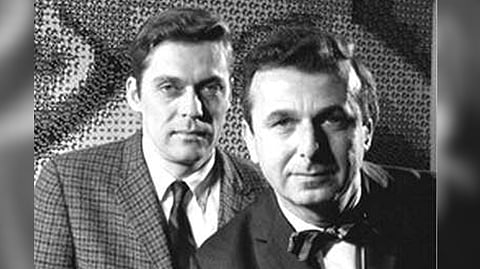

NEW YORK: Ken Knowlton, an engineer, computer scientist and artist who helped pioneer the science and art of computer graphics and made many of the first computer-generated pictures, portraits and movies, died June 16 in Sarasota, Florida.
He was 91. In 1962, after finishing a doctorate in electrical engineering, Ken Knowlton joined Bell Labs in Murray Hill, New Jersey, a future-focused division of the Bell telephone conglomerate that was among the world’s leading research labs.
After learning that the lab had installed a new machine that could print images onto film, he resolved to make movies using computer-generated graphics.
“You could make pictures with letters on the screen or spots on the screen or lines on the screen,” he said in a 2016 interview, recalling his arrival at Bell Labs. “How about a movie?” Over the next several months, he developed what he believed to be the first computer programming language for computer animation, called BEFLIX (short for “Bell Labs Flicks”).
The following year, he used this language to make an animated movie. Called “A Computer Technique for the Production of Animated Movies,” this 10-minute film described the technology used to make it.
Although Knowlton was the only person to ever use the BEFLIX language — he and his colleagues quickly replaced it with other tools and techniques — the ideas behind this technology would eventually overhaul the movie business. By the mid-1980s, computer graphics were an integral part of feature films like “Tron” and “The Last Starfighter.”
In 1995, a studio in Northern California, Pixar, released “Toy Story,” a feature film whose images were generated entirely by computer. Today, computer-generated imagery, or CGI, plays a role in practically every movie and television show.
“He was the first man to fill a movie screen with pixels,” said Ted Nelson, a computer science pioneer and philosopher who wrote about Knowlton’s early work. “Now, every movie you see was created on a digital machine.”
After graduating a year early from high school as class valedictorian, Knowlton enrolled in a five-year engineering and physics program at Cornell University, where his parents had first met while studying agriculture before deciding to buy a farm. He stayed at Cornell for a master’s degree, which involved building an X-ray camera using parts from an electron microscope. At Bell Labs, Knowlton realised that he could create detailed images by stringing together dots, letters, numbers and other symbols generated by a computer. Each symbol was chosen solely for its brightness — how bright or how dark it appeared at a distance. His computer programs, by carefully changing brightness as they placed each symbol, could then build familiar images, like flowers or faces. Knowlton remained at Bell Labs until 1982, experimenting with everything from computer-generated music to technologies that allowed deaf people to read sign language over the telephone. He later joined Wang Laboratories, where, in the late 1980s, he helped develop a personal computer that let users annotate documents with synchronised voice messages and digital pen strokes.
In 2008, after retiring from tech research, he joined a magician and inventor named Mark Setteducati in creating a jigsaw puzzle called Ji Ga Zo, which could be arranged to resemble anyone’s face.
“He had a mathematical mind combined with a great sense of aesthetics,” Setteducati said.
Visit news.dtnext.in to explore our interactive epaper!
Download the DT Next app for more exciting features!
Click here for iOS
Click here for Android